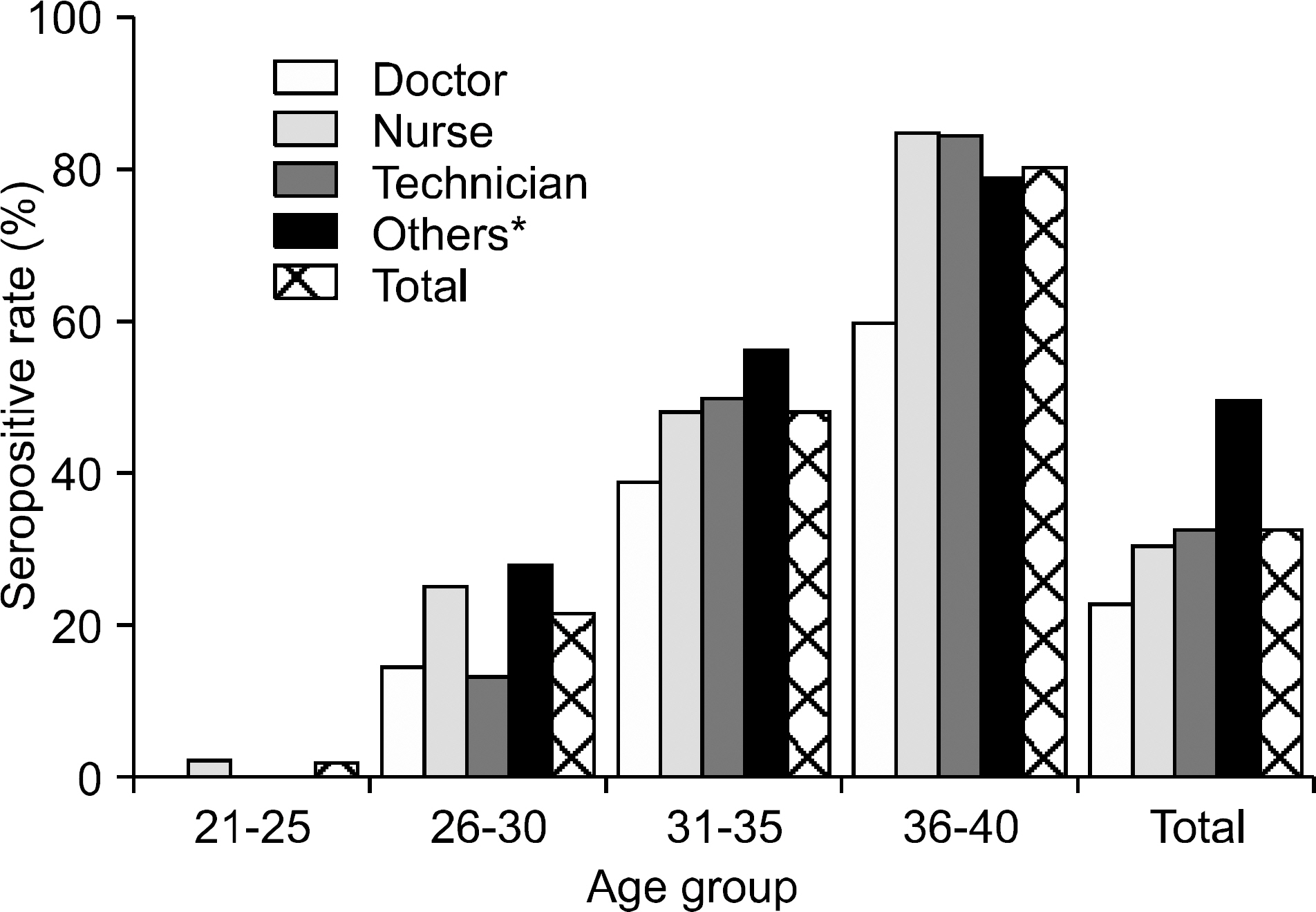Korean J Gastroenterol.
2010 Mar;55(3):183-188. 10.4166/kjg.2010.55.3.183.
Seroprevalence of IgG Anti-HAV in Hospital Employees below 40 Years Old
- Affiliations
-
- 1Department of Internal Medicine, Chonnam National University Medical School, Gwangju, Korea. choisk@jnu.ac.kr
- KMID: 1775900
- DOI: http://doi.org/10.4166/kjg.2010.55.3.183
Abstract
- BACKGROUND/AIMS
Hepatitis A is an acute infectious disease transmitted by fecal-oral route. As the incidence of hepatitis A has been increased in Gwangju and Chonnam province of Korea recently, the number of hepatitis A patients in hospital employees has also increased. Thus, we investigated the seroprevalence of IgG anti-HAV in hospital employees below 40 years old.
METHODS
We analysed the seroprevalence of anti-HAV IgG from 1,002 Chonnam national university hospital empolyees (men: 190, women: 812) who were below 40 years old. The age group was divided by 5 years; 21-25 years old 199 (19.9%), 26-30 years old 426 (42.5%), 31-35 years old 215 (21.5%), 36-40 years old 162 (16.1%).
RESULTS
Overall seropositive rate of IgG anti-HAV was 32.8% (329/1,002). The seropositive rate of men was 40.5% (77/190) and that of women was 31.0% (252/812). The seropositive rates of each age group were 1.5% (3/199) in 21-25 years old, 21.6% (92/426) in 26-30 years old, 48.4% (104/215) in 31-35 years old, and 80.2% (130/162) in 36-40 years old. The seropositivity rate of the high risk group (doctors, nurses, technicians) was 28.9% (234/809).
CONCLUSIONS
The seropositive rate of IgG anti-HAV was the lowest in early twenties of hospital employees and below 50% in early thirties. Therefore, hepatitis A vaccination may be warranted in the hospital empolyees below the early thirties.
Keyword
MeSH Terms
Figure
Cited by 1 articles
-
Molecular and Clinical Characterization of Hepatitis A Virus in Gwangju and Jeonnam Province
Du Young Noh, Sung Bum Cho, Yeon Joo Kim, Wan Sik Lee, Chang Hwan Park, Young Eun Joo, Hyen Soo Kim, Jong Sun Rew, Sung Kyu Choi
Korean J Gastroenterol. 2011;57(6):346-351. doi: 10.4166/kjg.2011.57.6.346.
Reference
-
1. Feinstone SM, Kapikian AZ, Purceli RH. Hepatitis A: detection by immune electron microscopy of a virus-like antigen associated with acute illness. Science. 1973; 182:1026–1028.
Article2. Advisory Committee on Immunization Practices (ACIP). Fiore AE, Wasley A, Bell BP. Prevention of hepatitis A through active or passive immunization: recommendations of the Advisory Committee on Immunization Practices (ACIP). MMWR Recomm Rep. 2006; 55:1–23.3. Gandolfo GM, Ferri GM, Conti L, et al. Prevalence of infections by hepatitis A, B, C and E viruses in two different socioeconomic groups of children from Santa cruz, Bolivia. Med Clin (Barc). 2003; 120:725–727.
Article4. Nelson KE. Global changes in the epidemiology of hepatitis A virus infections. Clinical Infectious Disease. 2006; 42:1151–1152.
Article5. Hong WS, Kim CY. Seroepidermiology of type A and type B hepatitis in seoul area. Korean J Internal Med. 1982; 25:19–26.6. Choi W, Eom HS, Kim IH, et al. Pattern of acute hepatitis A and anti-HAV seroprevalence of Kyungin province. Korean J Gastroenterol. 1999; 34:69–75.7. Kim NJ, Sung JK, Lee SW, et al. An outbreak of hepatitis A in Taejeon city. Korean J Gastroenterology. 1999; 34:205–212.8. Shapiro CN, Coleman PJ, McQuillan GM, Alter MJ Margolis HS. Epidemiology of hepatitis A: seroepidemiology and risk groups in the USA. Vaccine. 1992; 10(suppl 1):S59–S62.
Article9. Hadler SC, Webster HM, Erben JJ, Swanson JE, Maynard JE. Hepatitis A in day-care centers. A community-wide assessment. N Engl J Med. 1980; 302:1222–1227.10. Lednar WM, Lemon SM, Kirkpatrick JW, Redfield RR, Fields ML, Kelley PW. Frequency of illness associated with epidemic hepatitis A virus infection in adults. Am J Epidemiology. 1985; 122:226–233.11. Sleisenger MH. Gastrointestinal and liver disease. Volume 2. 8th ed.Philadelphia: WB Saunders;2006.12. Akriviadis EA, Redeker AG. Fulminant hepatitis A in intravenous drug users with chronic liver disease. Ann Intern Med. 1989; 110:838–839.
Article13. Vento S, Garofano T, Renzini C, et al. Fulminant hepatitis associated with hepatitis A virus superinfection in patients with chronic hepatitis C. N Engl J Med. 1998; 338:286–290.
Article14. Keeffe EB. Is hepatitis A more severe in patients with chronic hepatitis B and other chronic liver diseases? Am J Gastroenterology. 1995; 90:201–205.15. Papaevangelou GJ, Roumeliotou-Karayannis AJ, Contoyannis PC. The risk of nosocomial hepatitis A and B virus infections from patients under care without isolation precaution. J Med Virol. 1981; 7:143–148.
Article16. Goodman RA, Carder CC, Allen JR, Orenstein WA, Finton RJ. Nosocomial hepatitis A transmission by an adult patient with diarrhea. Am J Med. 1982; 73:220–226.
Article17. Shimizu H, Takebayashi T, Goto M, Togashi T. Studies on an outbreak of hepatitis A in an institution for the mentally retarded children. Hokkaido Igaku Zasshi. 1984; 59:247–253.18. Klein BS, Michaels JA, Rytel MW, Berg KG, Davis JP. Nosocomial hepatitis A. A multinursery outbreak in Wis-consin. JAMA. 1984; 252:2716–2721.
Article19. Kang CI, Choi CM, Park TS, Lee DJ, Oh MD, Choe KW. Incidence and seroprevalence of hepatitis A virus infections among young Korean soldiers. J Korean Med Sci. 2007; 22:546–548.
Article20. Jindal M, Rana SS, Gupta RK, Das K, Kar P. Serological study of hepatitis A virus infection amongst the students of a medical college in Delhi & evaluation of the need of vaccination. Indian J Med Res. 2002; 115:1–4.21. Kim TY, Sohn JH, Ahn SB, et al. Comparison of recent IgG Anti-HAV prevalence between two hospitals in Seoul and Gyeonggi area. Korean J Hepatology. 2007; 13:363–369.
Article22. Korean society of pediatrics. Guidelines for preventive vaccination. 5th ed.Reston: Kwangmun Publishing Co.;2002.
- Full Text Links
- Actions
-
Cited
- CITED
-
- Close
- Share
- Similar articles
-
- Seroprevalence of Hepatitis A in a Manufacture Workplace
- Changes in the seroprevalence of IgG anti-hepatitis A virus between 2001 and 2013: experience at a single center in Korea
- An Epidemiologic Study on the Seropositive Rate of Hepatitis A Virus in Children of Gwangju and Jeonnam
- Recent Seroprevalence of Anti-hepatitis A IgG in the Korean Population: a Large, Population-based Study
- A seroepidemiologic and it's 1 year follow up study on anti HAV IgG for college students living in dormitory





